Martensitic Transformation and Magnetic-Field-Induced Strain in High-Entropy Magnetic Memory Alloy Ni20Mn20Ga20Gd20Co20 by Hot-Magnetic Drawing
Abstract
:1. Introduction
2. Materials and Methods
2.1. Sample Preparation
2.2. Microstructure Observation and Performance Test
3. Results and Discussion
3.1. Microstructure and Composition Distribution
3.2. Phase Transition Temperature and Martensite Structure
3.3. Shape Memory Effect and Magnetic-Field-Induced Strain
3.4. Discussion
3.4.1. Discussion on Microstructure and Martensite Transition
3.4.2. Discussion on SME and MFIS
4. Conclusions
Author Contributions
Funding
Institutional Review Board Statement
Informed Consent Statement
Data Availability Statement
Conflicts of Interest
References
- Salas, D.; Wang, Y.; Duong, T.C.; Attari, V.; Ren, Y.; Chumlyakov, Y.; Arroyave, R.; Karaman, I. Competing interactions between mesoscale length-scales, order-disorder, and martensitic transformation in ferromagnetic shape memory alloys. Acta Mater. 2021, 206, 116616. [Google Scholar] [CrossRef]
- Zhang, Y.; Guo, J.; Zhong, M.; Xiang, W.; Wu, Z. Martensitic transformation behaviour and mechanical property of dual-phase Ni-Co-Mn-Sn-Fe ferromagnetic shape memory alloys. J. Magn. Magn. Mater. 2021, 521, 167540. [Google Scholar] [CrossRef]
- Ju, J.; Liu, H.; Xu, Y.; Lou, S.; Yan, C. Microstructure evolution and mechanical improvement by rapid solidification of polycrystalline Co35Ni32Al32Dy alloy. Mater. Res. Express 2019, 12, 126545. [Google Scholar] [CrossRef]
- Federico, G.; Osvaldo, A.; Ricardo, R.; Fernando, L.; Jose, I.; Vicente, R.; Vicente, S.; Jose, A.; Fernando, P. Elastic and plastic strains misfits during the reverse martensitic transformation. Metall. Mater. Trans. A 2022, 2, 706–722. [Google Scholar]
- Matsuda, M.; Yasumoto, Y.; Hashimoto, K.; Hara, T.; Nishida, M. Transmission electron microscopy of twins in 10M martensite in Ni-Mn-Ga ferromagnetic shape memory alloy. Mater. Trans. 2012, 53, 902–906. [Google Scholar] [CrossRef] [Green Version]
- Saren, A.; Nicholls, T.; Tellinen, J.; Ullakko, K. Direct observation of fast-moving twin boundaries in magnetic shape memory alloy Ni-Mn-Ga 5 M martensite. Scr. Mater. 2016, 123, 9–12. [Google Scholar] [CrossRef]
- Hosoda, H.; Lazarczyk, J.; Sratong-on, P.; Tahara, M.; Chernenko, V. Elaboration of magnetostrain-active NiMnGa particles/polymer layered composites. Mater. Lett. 2021, 289, 129427. [Google Scholar] [CrossRef]
- Pradeep, K.; Vinita; Shuvam, B.; Jitendra, S.; Davinder, K. Magnetic field tunable ferromagnetic shape memory alloy-based SAW resonator. IEEE Electron Device Lett. 2022, 3, 446–449. [Google Scholar]
- Yu, H.; Qiu, Y.; Young, M.L. Influence of Ni4Ti3 precipitate on pseudoelasticity of austenitic NiTi shape memory alloys deformed at high strain rate. Mater. Sci. Eng. A 2021, 804, 140753. [Google Scholar] [CrossRef]
- Chen, H.; Ju, J.; Shuai, L.; Liu, H.; Yan, C.; Liu, Z. Structure and martensitic transformation in rapidly solidified CoNiAlFe alloy. Matels 2017, 7, 473. [Google Scholar] [CrossRef] [Green Version]
- Larissa, M.-G.; Igor, M.; Milan, O.; Jozef, V.; Jan, C.; Peter, M.; Jan, C.; Antonin, Z.; Vit, J.; Ivo, D. High-strength Al0.2Co1.5CrFeNi1.5Ti high-entropy alloy produced by powder metallurgy and casting: A comparison of microstructures, mechanical and tribological properties. Mater. Charact. 2020, 159, 110046. [Google Scholar]
- Kilmametov, A.; Kulagin, R.; Mazilkin, A.; Seils, S.; Boll, T.; Heilmaier, M.; Hahn, H. High-pressure torsion driven mechanical alloying of CoCrFeMnNi high entropy alloy. Scr. Mater. 2019, 158, 29–33. [Google Scholar] [CrossRef]
- Chen, C.; Wong, K.; Krishnan, R.P.; Zhifeng, L.; Yu, D.; Lu, Z.; Chathoth, S.M. Highly collective atomic transport mechanism in high-entropy glass-forming metallic liquids. J. Mater. Sci. Technol. 2019, 35, 44–47. [Google Scholar] [CrossRef]
- Mehta, A.; Sohn, Y. Investigation of sluggish diffusion in FCC Al0.25CoCrFeNi high-entropy alloy. Mater. Res. Lett. 2021, 9, 239–246. [Google Scholar] [CrossRef]
- Hashimoto, N.; Alzain, Y.; Yamamoto, A.; Koyano, T.; Kim, H.Y.; Miyazaki, S. Novel beta-type high entropy shape memory alloys with low magnetic susceptibility and high biocompatibility. Mater. Lett. 2021, 287, 129286. [Google Scholar] [CrossRef]
- Gao, J.J.; Xuan, J.M.; Li, F.; Wan, Y.Q.; Zhu, J. Study on magnetoresistance of Ni48Mn22Ga22Co4Cu4 microwires. Solid State Commun. 2021, 323, 114112. [Google Scholar] [CrossRef]
- Zhang, H.H.; Qian, M.F.; Zhang, X.X.; Jiang, S.D.; Wei, L.S.; Xing, D.W.; Sun, J.F.; Geng, L. Magnetocaloric effect of Ni-Fe-Mn-Sn microwires prepared by melt-extraction technique. Mater. Des. 2017, 114, 1–9. [Google Scholar] [CrossRef]
- Liu, Y.F.; Luo, L.; Zhang, X.X.; Shen, H.X.; Liu, J.S.; Sun, J.F.; Zu, N.N. Magnetostructural coupling induced magnetocaloric effects in Ni-Mn-Ga-Fe microwires. Intermetallics 2019, 112, 106538. [Google Scholar] [CrossRef]
- Cai, H.; Zhang, Y.; Li, X.; Meng, J.; Xue, F.; Chu, C.L.; Tao, L.; Bai, J. Self-reinforced biodegradable Mg-2Zn alloy wires/polylactic acid composite for orthopedic implants. Compos. Sci. Technol. 2018, 162, 198–205. [Google Scholar] [CrossRef]
- Ju, J.; Lou, S.; Yan, C.; Yang, L.; Li, T.; Hao, S.; Wang, X.; Liu, H. Microstructure, magnetism and magnetic field induced-strain in Er-Doped Co-Ni-Al polycrystalline alloy. J. Electron. Mater. 2017, 46, 2540–2547. [Google Scholar] [CrossRef]
- Zhao, K.; Li, X.; Su, D. High-entropy alloy nanocatalysts for electrocatalysis. Acta Phys. Chim. Sin. 2021, 37, 2009077. [Google Scholar] [CrossRef]
- Isogami, S.; Uzuhashi, J.; Ohkubo, T.; Hayashi, M. Crystalline-structure-dependent magnetoresistance in ferromagnetic metal/conducting amorphous oxide heterostructures. Phys. Rev. Mater. 2019, 2, 024408. [Google Scholar] [CrossRef]
- Preziosi, D.; Homkar, S.; Lefevre, C.; Salluzzo, M.; Viart, N. Unusual anisotropic magnetic orbital moment obtained from X-ray magnetic circular dichroism in a multiferroic oxide system. Phys. Rev. B 2021, 18, 184420. [Google Scholar] [CrossRef]
- Chen, Y.J.; Wang, J.M.; Jiang, C.B. Tailoring ferroic domains by introducing internal stress: Fe81Ga19 magnetostrictive alloy as an example. Appl. Phys. Lett. 2018, 11, 112405. [Google Scholar] [CrossRef]
- Ju, J.; Yang, L.; Hao, S.; Mao, Q.; Lou, S.; Liu, H. Microstructure, martensite transition and mechanical properties investigations of polycrystalline Co-Ni-Al alloys with Er doping. J. Mater. Eng. Perform. 2017, 3, 1062–1068. [Google Scholar] [CrossRef]
- Yu, C.; Kang, G.Z.; Rao, W.; Song, D. Modelling the stress-induced multi-step martensite transformation of single crystal NiMnGa ferromagnetic shape memory alloys. Mech. Mater. 2019, 134, 204–218. [Google Scholar] [CrossRef]
- Chang, S.H.; Kuo, C.; Lin, C.; Wu, S.K. Martensitic transformation and damping capacities of Ni50Mn40−xSn10+x (x = 0–4 at.%) ferromagnetic shape memory alloys. J. Mater. Res. 2021, 8, 1686–1694. [Google Scholar] [CrossRef]
- Ju, J.; Liu, H.; Shuai, L.G.; Liu, Z.; Kang, Y.; Yan, C.; Li, H. Martensite transformation and mechanical properties of polycrystalline Co-Ni-Al alloys with Gd doping. Matels 2018, 8, 848. [Google Scholar] [CrossRef] [Green Version]
- Ju, J.; Hu, L.; Bao, C.W.; Shuai, L.G.; Yan, C.; Wang, Z.R. Microstructure and magnetic field-induced strain of a Ni-Mn-Ga-Co-Gd high-entropy Alloy. Materials 2021, 10, 2514. [Google Scholar] [CrossRef]
- Hao, C.X.; Wang, Y.; Wang, J.T.; Liang, C.X.; Duan, D.; Wang, D.; Yang, S.; Song, X.P. Kinetic arrest behavior in Ni-Co-Mn-Sn alloys within the phase boundary between martensite and strain glass. Scr. Mater. 2021, 194, 113671. [Google Scholar] [CrossRef]
- Ju, J.; Lou, S.; Yang, L.; Li, T.; Hao, S.; Yan, C. Effect of electronic and magnetic valences on phase transition and magnetic properties in Co-Ni-Al-RE (RE = Gd, Dy and Er) alloys. J. Electron. Mater. 2017, 2, 1390–1395. [Google Scholar] [CrossRef]
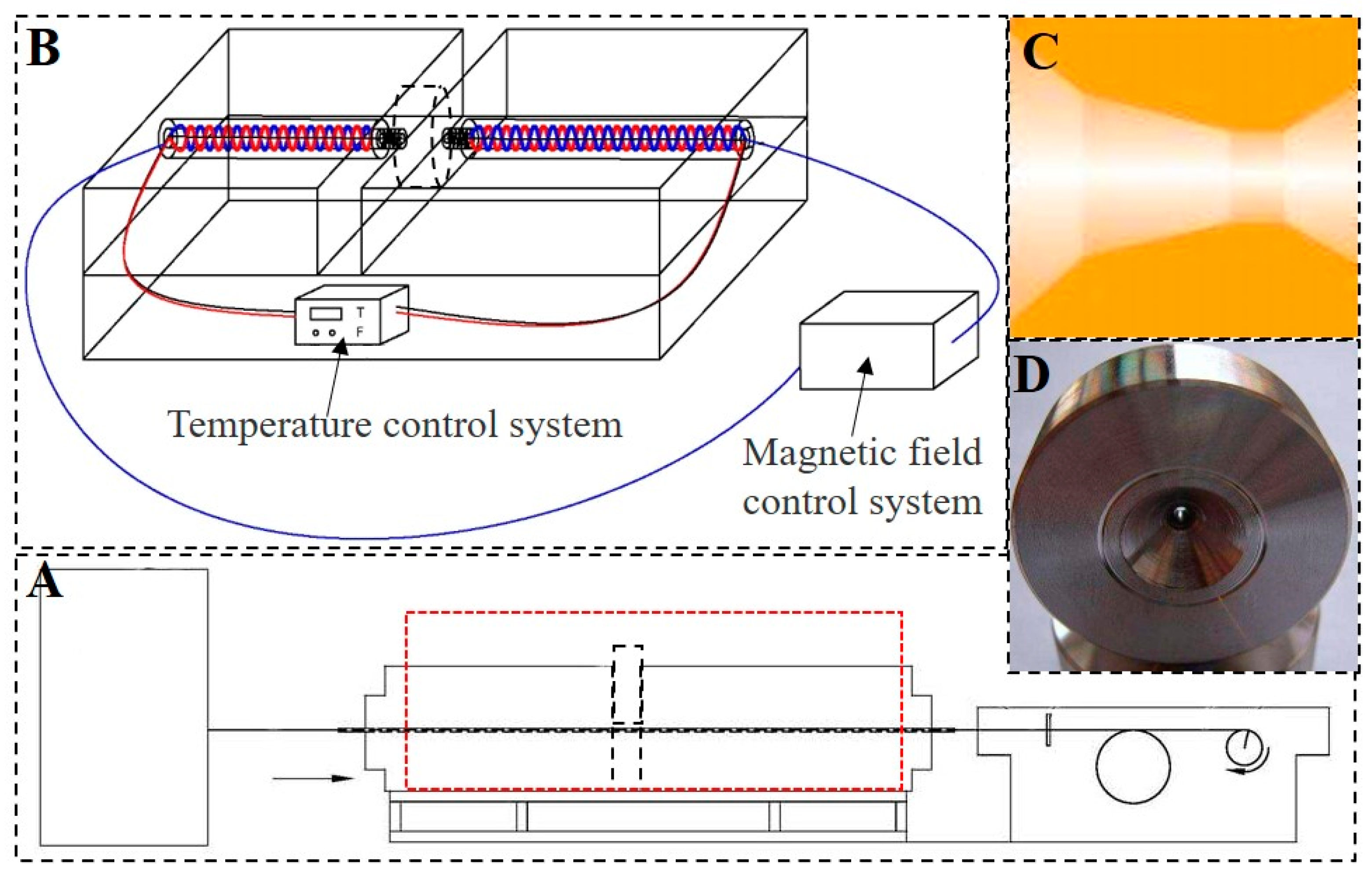
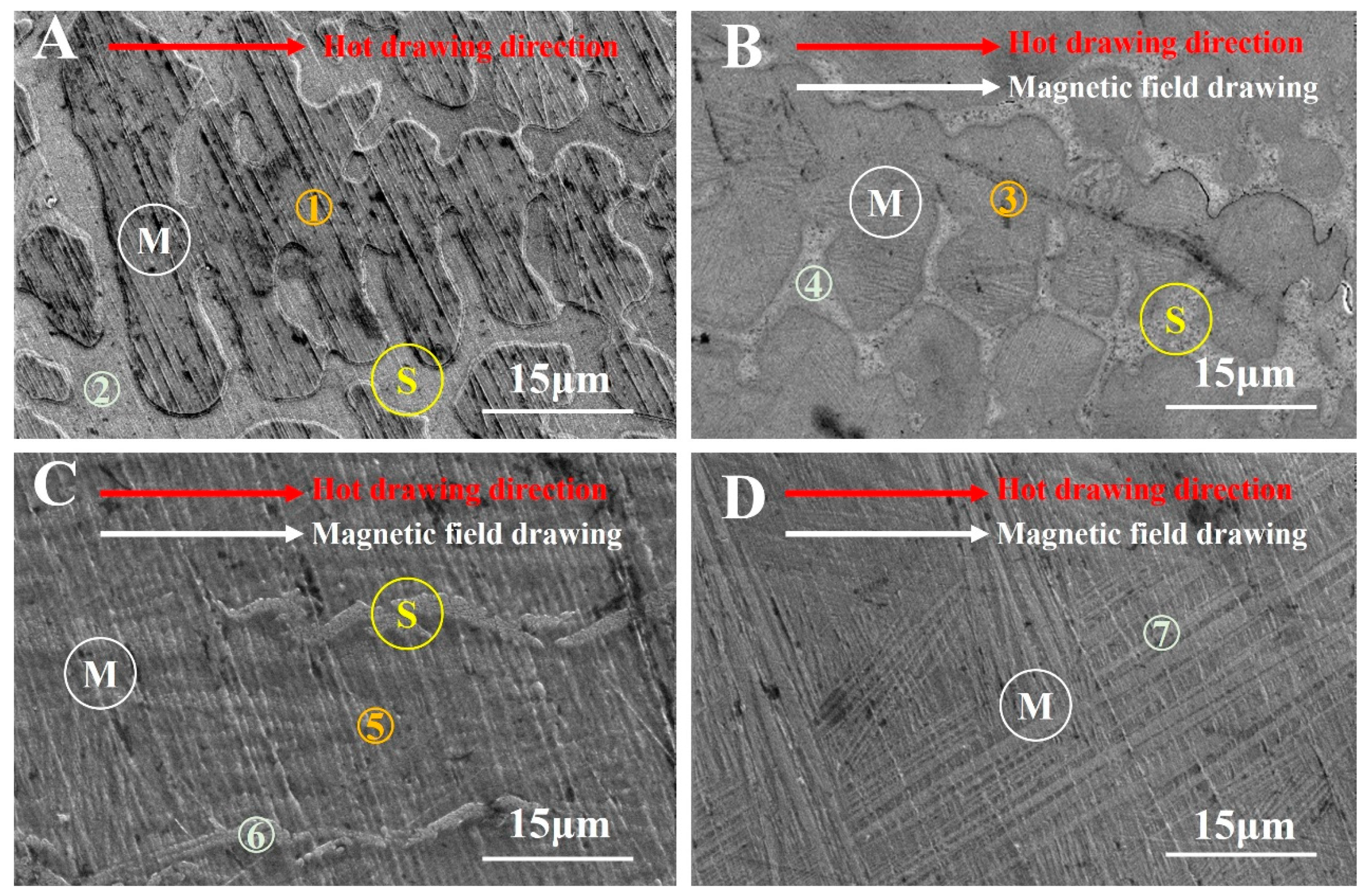


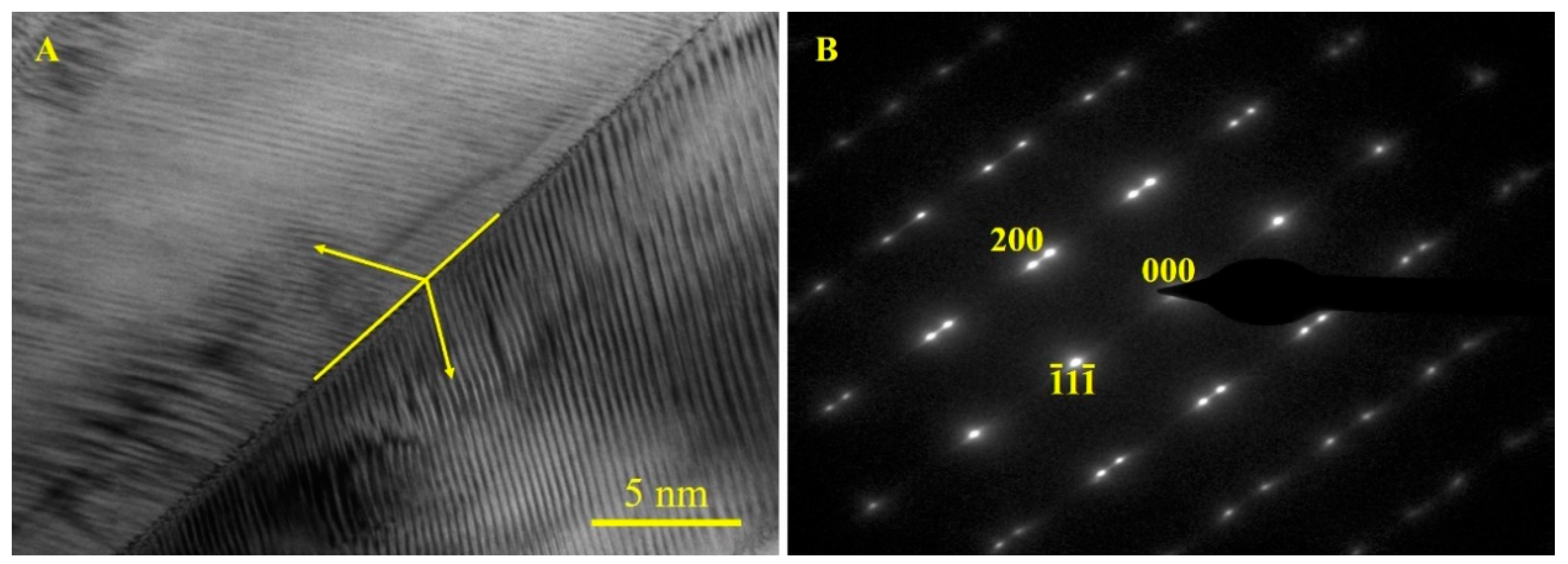
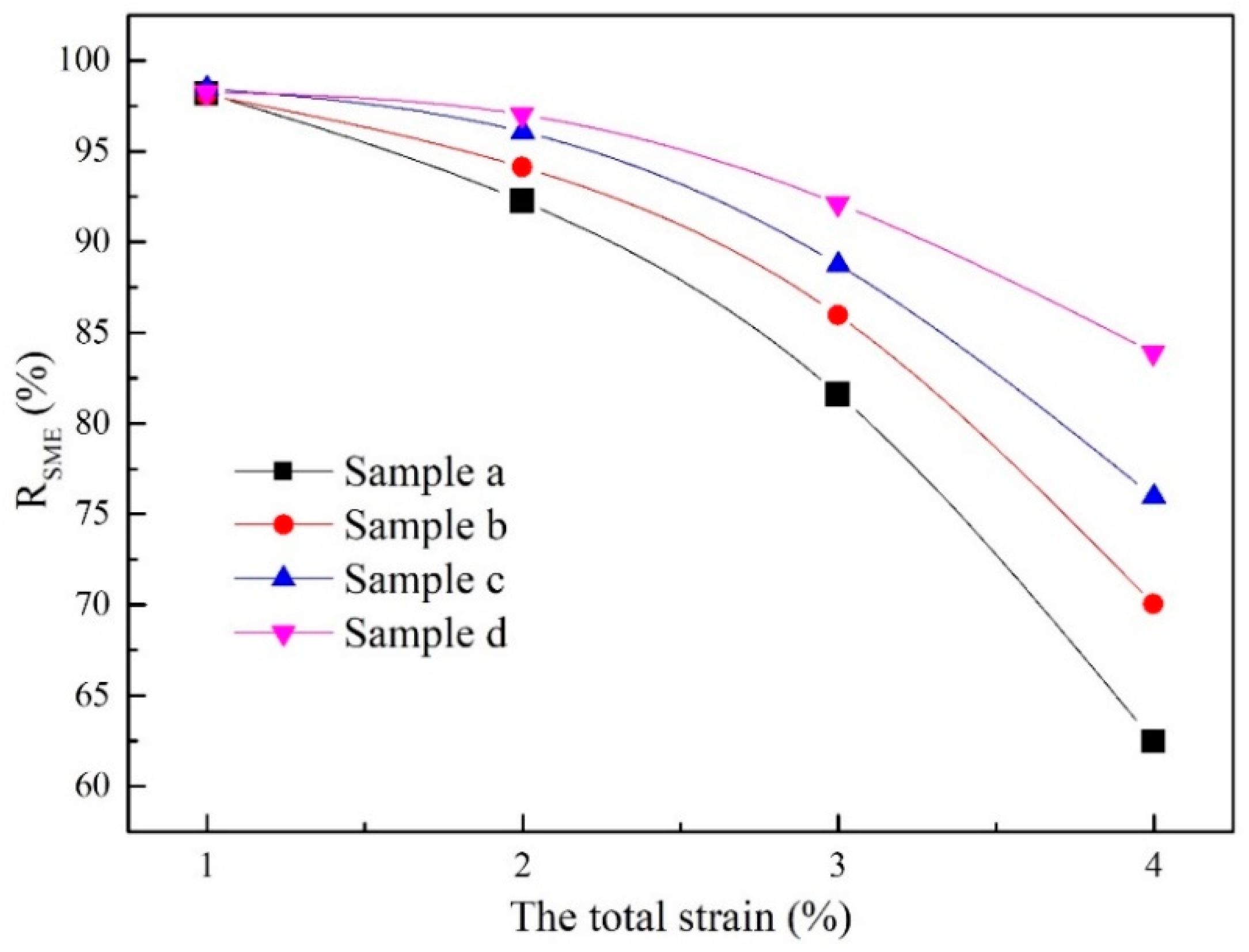

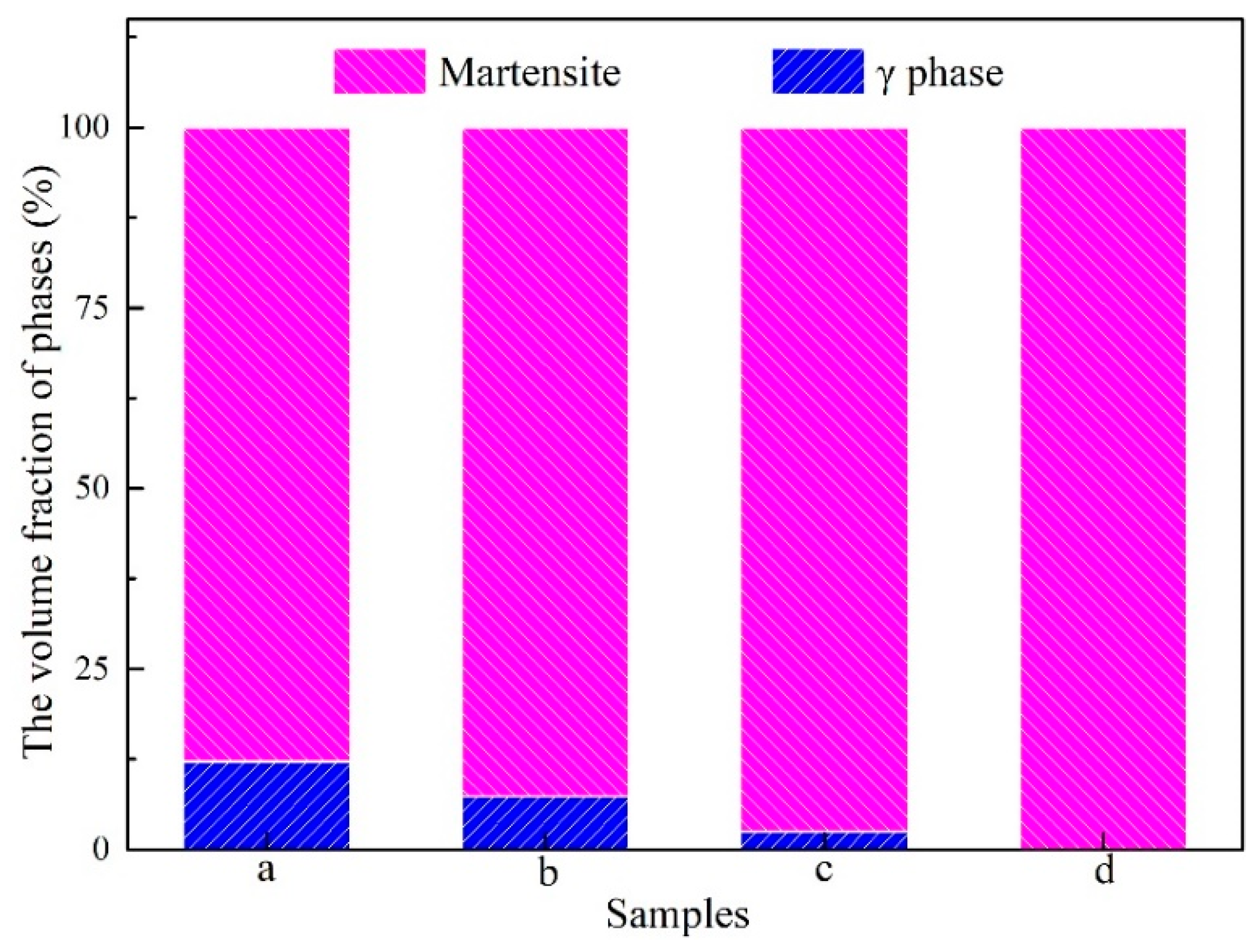

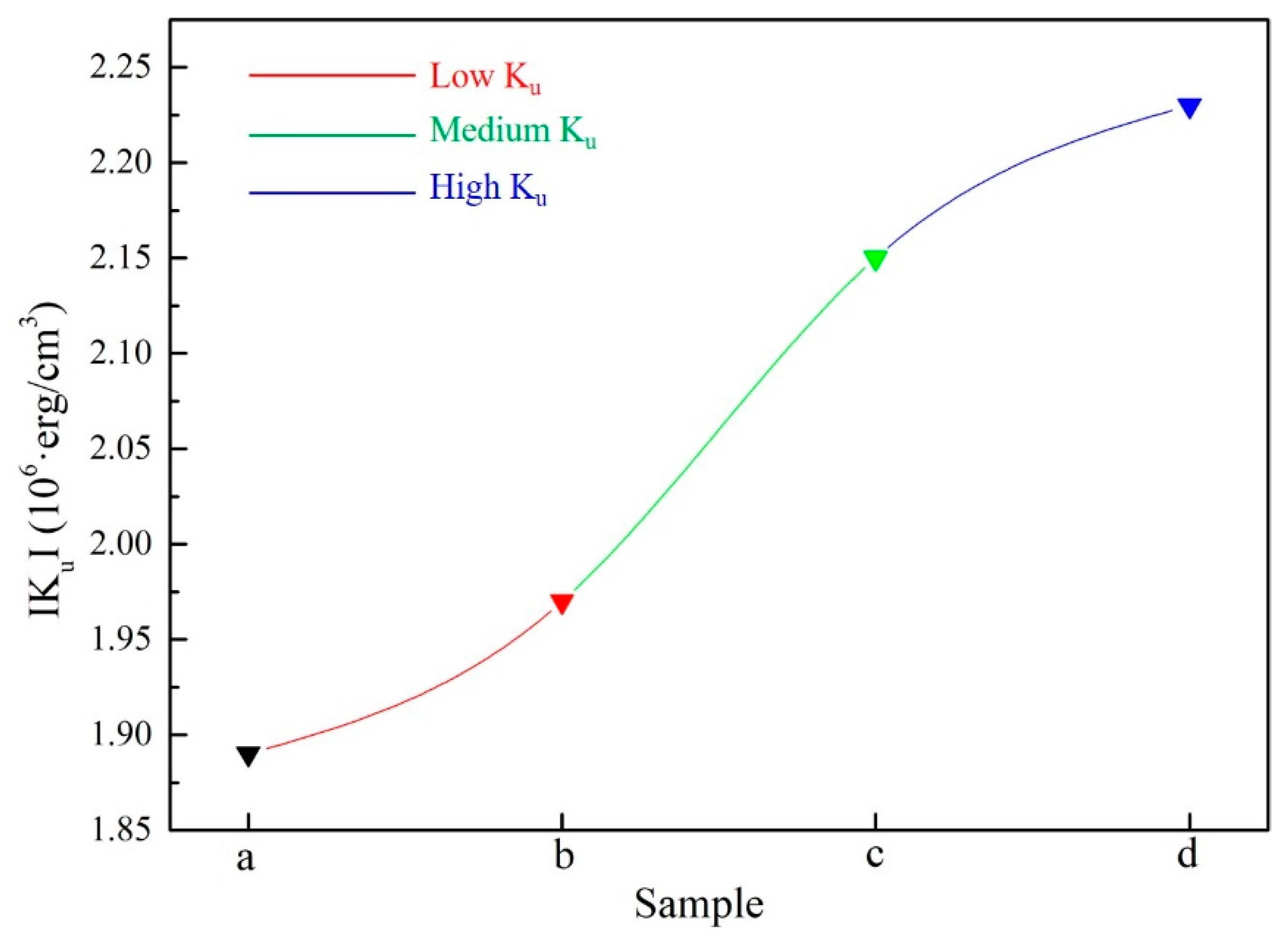
| Samples | Nominal Compositions (at.%) | Hot-Magnetic Drawing Condition | |||
|---|---|---|---|---|---|
| Temperature | Magnetic Field | Drawing Speed | Single-Pass Deformation | ||
| a | Ni20Mn20Ga20Gd20Co20 | 500 °C | 0 T | 10 mm/s | 20% |
| b | Ni20Mn20Ga20Gd20Co20 | 500 °C | 0.1 T | 10 mm/s | 20% |
| c | Ni20Mn20Ga20Gd20Co20 | 500 °C | 0.2 T | 10 mm/s | 20% |
| d | Ni20Mn20Ga20Gd20Co20 | 500 °C | 0.5 T | 10 mm/s | 20% |
| Scan Area in SEM Image | Actual Compositions (at.%) | Approximate Atomic Ratio | ||||
|---|---|---|---|---|---|---|
| Ni | Mn | Ga | Gd | Co | ||
| ① | 19.3 | 20.1 | 20.4 | 19.8 | 20.4 | 1:1:1:1 |
| ② | 12.4 | 12.6 | 12.6 | 29.8 | 32.6 | 1:1:1: 2.4:2.6 |
| ③ | 20.1 | 20.3 | 19.8 | 19.7 | 20.1 | 1:1:1:1 |
| ④ | 13.4 | 13.8 | 13.7 | 28.9 | 30.2 | 1:1:1:2.1:2.2 |
| ⑤ | 19.8 | 19.9 | 20.3 | 19.8 | 20.2 | 1:1:1:1:1 |
| ⑥ | 16.1 | 16.3 | 16.2 | 24.7 | 26.7 | 1:1:1:1.5:1.7 |
| ⑦ | 19.9 | 20.6 | 19.5 | 20.5 | 19.5 | 1:1:1:1 |
Publisher’s Note: MDPI stays neutral with regard to jurisdictional claims in published maps and institutional affiliations. |
© 2022 by the authors. Licensee MDPI, Basel, Switzerland. This article is an open access article distributed under the terms and conditions of the Creative Commons Attribution (CC BY) license (https://creativecommons.org/licenses/by/4.0/).
Share and Cite
Ju, J.; Fang, M.; Shuai, L.; Yin, K. Martensitic Transformation and Magnetic-Field-Induced Strain in High-Entropy Magnetic Memory Alloy Ni20Mn20Ga20Gd20Co20 by Hot-Magnetic Drawing. Materials 2022, 15, 2785. https://doi.org/10.3390/ma15082785
Ju J, Fang M, Shuai L, Yin K. Martensitic Transformation and Magnetic-Field-Induced Strain in High-Entropy Magnetic Memory Alloy Ni20Mn20Ga20Gd20Co20 by Hot-Magnetic Drawing. Materials. 2022; 15(8):2785. https://doi.org/10.3390/ma15082785
Chicago/Turabian StyleJu, Jia, Mengfei Fang, Liguo Shuai, and Kang Yin. 2022. "Martensitic Transformation and Magnetic-Field-Induced Strain in High-Entropy Magnetic Memory Alloy Ni20Mn20Ga20Gd20Co20 by Hot-Magnetic Drawing" Materials 15, no. 8: 2785. https://doi.org/10.3390/ma15082785





